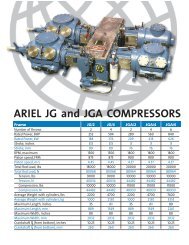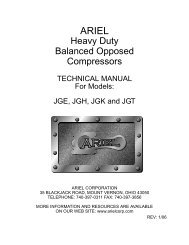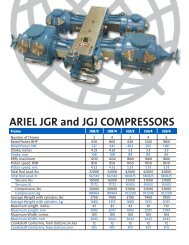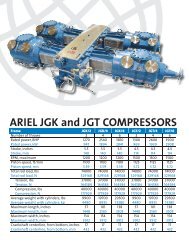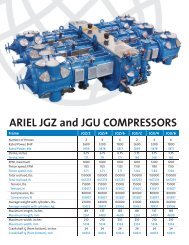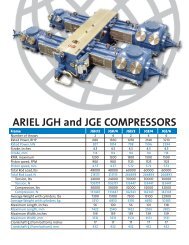Heavy Duty Balanced Opposed Compressors
Heavy Duty Balanced Opposed Compressors
Heavy Duty Balanced Opposed Compressors
Create successful ePaper yourself
Turn your PDF publications into a flip-book with our unique Google optimized e-Paper software.
FOR MODELS: JG AND JGA SECTION 5 - MAINTENANCE<br />
equally spaced. This prevents the stack of parts from being aligned incorrectly.<br />
Remove the stud nuts and the pressure packing can be un-stacked. Replace<br />
these nuts each time the pressure packing is serviced.<br />
7. Ring wear can be determined by placing the assembled rings, (note matchmarks),<br />
on the piston rod. Check end gap clearance. If the ends butt, or nearly<br />
butt, they should be replaced by new rings.<br />
8. Fins or wire edges on the rings due to wear should be carefully filed off so that<br />
all matching edges will be square.<br />
9. The metal gasket on the end cup can be pried loose with a sharp awl. Be careful<br />
not to scratch the sides of the gasket groove.<br />
10. Before reassembly be certain all parts are perfectly clean.<br />
Piston Rod Packing - Reassembly<br />
1. Be sure to refer to the pressure packing assembly in your parts book. Please<br />
contact your distributor if you do not have a parts book. A pressure packing<br />
assembly drawing also is packaged with each pressure packing re-build kit.<br />
2. If installing a new set of rod rings in an existing packing case, the case parts<br />
need to be inspected for wear. Cups should be smooth and flat on the back side<br />
where the rod rings must seal. If the cups or grooves have worn concave or<br />
tapered, they should be reground or relapped. It is rarely necessary to alter the<br />
crosshead side of the cups, however, if this is found necessary, care must be<br />
taken so that the correct side clearance for the renewal rings is not destroyed.<br />
NOTE: IF PREMATURE WEAR IS SUSPECTED, REFER TO THE ARIEL See “Cylinder<br />
And Packing Lubrication Requirements” on page 4-5.<br />
3. Before a packing case is installed, it should always be disassembled and thoroughly<br />
cleaned in an appropriate solvent for the intended service.<br />
4. Make sure that each rod ring and cup is properly positioned and that rings are<br />
liberally coated with a clean lubricant before reassembly. Examine all parts for<br />
unusual nicks or burrs which might interfere with the free floating of the rod ring<br />
in the cups. Particular care should be taken with rod rings made of soft materials,<br />
such as bronze or TFE, and it is extremely important that wiper rings be<br />
handled and installed so as to prevent damage to the scraping edges.<br />
5. Parts should be laid out on a work bench so that they can be installed progressively<br />
with each in its correct position and the rod rings with their proper faces<br />
toward the pressure. Note that all rod ring segments are carefully lettered and<br />
must be assembled accordingly. This is most important in order to ensure<br />
proper sealing. After the tie stud nuts are tightened, all rings should be free to<br />
“float” radially in each cup.<br />
6. For new installations, care must be given to the cleaning of all accumulated dirt<br />
in the lines and compressor because foreign material will lodge in the packing to<br />
become destructively abrasive.<br />
7. Prior to installing the packing case into the cylinder, the end cup gasket must be<br />
inspected for nicks and damage that would cause it to leak in service. When in<br />
doubt, replace the gasket with a new one.<br />
11/01 PAGE 5 - 25





